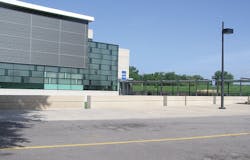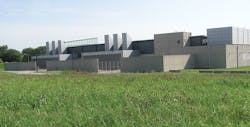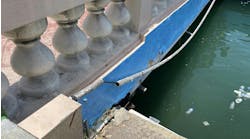Article 708 first appeared in the 2008 NEC. It provides the requirements for critical operations power systems (COPS). This Article has a large statement of scope [708.1]. Typically, Section 1 of an NEC Article is a short paragraph. In Article 708, it is two slightly beefy paragraphs followed by nine Informational Notes. It is here where we first find COPS defined.
The first paragraph explains to what Art. 708 applies. In that explanation, we find the phrase “designated critical operations areas” followed by the acronym DCOA. The second paragraph says when a power system is classed by a government agency (or facility engineering documentation) as being for a DCOA it’s a COPS [708.1]. We also find COPS defined in Section 2 (where you’d expect).
General power systems, HVAC, fire alarm, security, and communications systems for the DCOA are examples of COPS [708.1]. COPS are typically installed in vital infrastructure facilities that, if incapacitated, would disrupt national security, the economy, or public safety [708.1, Informational Note 1].
Know the risks
Risk assessment is the first requirement in Art. 708. The NEC is not saying that the electrical engineer is responsible for doing this assessment, but the NEC does make it clear one must be performed. The necessity for teamwork and interdisciplinary communication becomes apparent when you read the requirements for conducting one.
A risk assessment must be documented [708.4]. That sounds par for electrical work, but the Informational Note under 708.4 is a good clue this is going beyond what we think of as electrical work. That Informational Note refers to Chapter 5 of NFPA 1600-2013, Standard on Disaster/Emergency Management and Business Continuity Programs (it provides additional guidance for conducting risk assessment and hazard analysis).
The risk assessment must identify:
- Possible hazards.
- How likely those hazards are to occur.
- How vulnerable to those hazards the electrical system might be [708.4(A)].
At a minimum, the assessment must identify [708.4(B)]:
- Naturally occurring hazards (e.g., geological, meteorological, biological).
- Human-caused events, whether accidental or intentional [NFPA 1600 5.3.2].
It’s great if you figure out what can go wrong, but what are you going to do about it? The third plank of these requirements is the development and implementation of a risk mitigation strategy [708.4(C)].
The NEC doesn’t provide details on compliance, but there are industry standards and best practices. Some things you might do, for example, include:
- Address seismic issues (consult the seismic standards). You would, for example, provide more rigorous mounting of transformers.
- Build in redundant bonding. Many data centers run critical operations (by the Art. 708 definition), and most provide good examples of redundant bonding. They accomplish it by, for example, installing bonding jumpers at connection points and running an independent equipment “grounding” (bonding) jumper inside the raceway.
- Install a well-engineered transient protection system. Such a system isn’t a box you bolt to a panel somewhere. It consists of layers of protection, with each layer addressing a progressively lower energy level as you move from the utility side of the service toward the final branch circuit loads [708.20(D)].
Lock it down
Every electrical system should be have restricted access. But with COPS, the means of restriction must be rigorous. Simply posting “Authorized Personnel Only” signs on electrical room doors doesn’t cut it. You must make the OCPDs inaccessible to anyone but authorized persons [708.50]. This means, at a minimum, locked access.
With COPS, having adequate security is a Code compliance issue [708.5] and usually also a legal issue. If you’re doing electrical work in COPS, of course you’re not providing the overall security. But you will be interacting with it. Therefore, ensure all of your people understand and follow the rules.
If there’s a pressing need to violate something like card key access rules (e.g., don’t prop doors open), work that out with security. They may, for example, put the alarm on temporary hold and provide a human guard for a specified time.
You probably will be responsible for the aspects that involve electrical design and installation. For example, any disconnect you install may have to comply with a locking provision. Where such provisions aren’t explicitly specified, assume they are required and get a written exception rather than assume they aren’t required and then be stuck with rework.
Testing
While testing and maintenance are often minimized in commercial and industrial environments, as if they are costs to be avoided, that is not the case with COPS.
Any COPS system must meet commissioning requirements that include component and system tests, baseline maintenance testing, and functional performance testing [708.8]. Before going operational, the AHJ must conduct (or witness) a test of the complete system. Typically, a qualified testing firm will do the testing (per industry standards, including NFPA 110), and the AHJ will witness and sign off; this is known as “witness testing.”
Once operational, the COPS must periodically undergo this same testing. From then on, the maintenance department must conduct additional testing, following industry standards (including, for example, NFPA 70B) and practices [708.6]. Load testing is another requirement [708.6(E)].
The NEC requires a written record of maintenance [708.6(D)], but almost any facility with this sort of investment already has a computerized maintenance management system (CMMS) plus a formal testing and maintenance program. Typically, these facilities compare the results of scheduled maintenance testing to the baseline testing data required by 708.8(C). If the delta is outside pre-established limits, then a corrective action is scheduled.
Separation anxiety
You can’t mix COPS wiring with that of other systems [708.10(B)], except where COPS feeders are in transfer equipment enclosures. Toward this end, even boxes and enclosures must be readily identified as being part of the COPS [708.10(A)(1)].
And it’s not just the wiring system that has to follow separation rules. Even at the user end, you want separation. For example, all receptacles must be readily identifiable as COPS receptacles. The receptacle identification requirement is part of a larger strategy to ensure that branch circuits supplied by the COPS supply only equipment required for critical operations use [708.30].
Alternate power
The COPS must have an alternate power source. The requirements are spelled out in 708.20(E) through (H). For example, you can use storage batteries 708.20(E). However, the battery systems must meet specific requirements; among those, they must include an automatic battery charger. A requirement that all alternate sources must meet is that you must ground each one as a separately derived source, complying with 250.30 [708.20(C)].
The COPS must have enough capacity and rating to allow all COPS-designated loads to operate simultaneously [708.22(A)]. The alternate power source must be sized to operate the COPS for at least 72 hr at full load of DCOA [708.22(C)].
That doesn’t preclude using the same alternate power supply for COPS and other loads. But that power supply must have adequate capacity to serve all of those loads [708.22(B)]. This requirement has a loophole: You can use automatic selective load pickup and load shedding to ensure the COPS has enough power. Conduct load shedding to support loads in this order of priority:
- COPS and emergency circuits.
- Legally required standby circuits.
- Optional standby circuits.
Selective coordination
The ground-fault operation of the service and feeder disconnects must be fully selective so the feeder device (not the service device) opens when there’s a fault on the load side [708.52(D)]. This idea of isolating power loss to the circuit with the fault rather than letting it take down the whole supply extends through the entire COPS system. All OCDPs in the system must be selectively coordinated with all supply-side OCPDs.
Only a licensed professional engineer (PE) or other qualified person can perform the selective coordination study [708.54]. Make sure the study is documented and the documentation is available to anyone working on the system.
Keeping COPS straight
The main point to remember about COPS is that it’s all about ensuring critical operations don’t stop due to loss of power. The steps you must take are based partly on specific requirements in Art. 708 and partly on that risk assessment. Read both of these very carefully.
Lamendola is an electrical consultant located in Merriam, Kan. He can be reached at [email protected].






